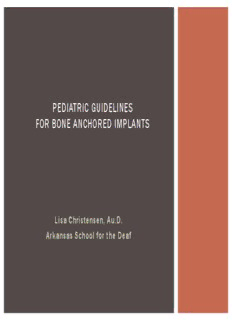
Pediatric Bone Anchored Implants - Z2 Systems, Inc. PDF
Preview Pediatric Bone Anchored Implants - Z2 Systems, Inc.
PEDIATRIC GUIDELINES FOR BONE ANCHORED IMPLANTS Lisa Christensen, Au.D. Arkansas School for the Deaf BONE ANCHORED IMPLANTS Osseointegrated devices have treating conductive and mixed hearing loss since 1977. Works through direct bone conduction. Sound is conducted through the skull bone bypassing the outer and middle ear and stimulating the cochlea. Contains three parts: titanium implant external abutment detachable sound processor BAHA – Entific Medical Systems Baha ™ Cochlear Americas Ponto – Oticon Medical Osseointegrated implants Bone Anchored Implants – BAI Aided testing - B CANDIDACY Softbands • No age restrictions • Bilateral CHL • Bilateral MHL • SSD or unilateral losses • Unilateral or bilateral softbands available Implants • FDA - age 5 years old or older • FDA: Bilateral implants (can be simultaneously implanted) must be symmetric bone conduction thresholds less than 10 dB difference on average (500, 1000, 2000, and 3000 Hz) or less than 15 dB at individual frequencies CANDIDACY Conductive Hearing Loss • TCS • Atresia/microtia MHL implants • Bilateral with BC PTA or 35 dB or less for children (Christensen) • Power devices • 5 years of age as other implantation guidelines Single sided deafness (SSD) • Unilateral hearing loss profound SNHL, MHL, or CHL • Normal (15 dB or less) in the “good ear” • Softband SOFTBANDS Yang, Stuart, Stenstrom, and Hollett (1991) – effect of contact force on ABR thresholds in newborns Measured click wave V 225, 325, 425, and 525 grams of force using an elastic band to couple the transducer to the head Latencies decreased as the contact force increased Increasing force to 525 grams caused the transducer to slip easily Recommended 400-450 grams on infants SOFTBANDS Clinically speaking – parents are typically instructed to tighten the softband to be snug but comfortable. Allowing no more than one or two fingers under the band. Hodgetts, Scollie, and Swain (2006) Measured the output vibratory force of a softband to an artificial mastoid 2, 3, 4, and 5 N (2N was defined as loose) Only slight differences between 2 and 5 N conditions were observed and they were only in high frequencies Suggested that a tight fitting softband may not be necessary to ensure adequate output Limitations – were on a stationary artificial masatoid with adult skull properties SOFTBANDS Skull location – mastoid placement of the bone transducer is generally more sensitive to bone conduction than forehead placement (McBride, Letowski, & Tran, 2008; Small, Hatton, & Stapells, 2007; Weston, Genel, & Hirsh, 1967) Yang, Rupert, & Moushegian (1987) using ABR wave V latencies for infants using mastoid and forehead placement Latencies were shorter with transducer on the mastoid in infants and adults Stuart, Yang, and Stenstrom (1990) ABR wave V latency bone conduction clicks in infants Moved transducer across 3 different positions on temporal bone Found shortest latencies on the mastoid however they noted that this placement is difficult to obtain in infants SOFTBAND FITTING • Placement of Baha Softband Infants - not always on mastoid Toddlers Preschoolers • Fitting the Softband Helping parents find the perfect fit • Functional gain/aided audiogram SOFTBANDS Flottorp & Solberg (1976) Examined impedance measurements at the mastoid and forehead at 10 different frequencies (125-6300 Hz) 9 to 71 years old This formed the basis of mechanic impedance estimated for the artificial mastoid standard It measured skin-covered impedance magnitude for children (9 years and older) Most of all the development in the skull, skin, and subcutaneous tissue have reached adult levels by the age of 9 years. There is still a research gap in children under the age of 9 years. SOFTBANDS: WHEN TO FIT Bilateral CHL/MHL will be fit ASAP • Just like traditional hearing aid fittings • Some will be implanted when they are 5 years old • Some will receive other surgical intervention Unilateral losses (SNHL/MHL/CHL) • fit at 9 to 12 months of age when we can get a Softband near the affected ear on a full time basis
Description: